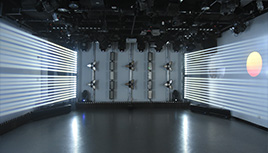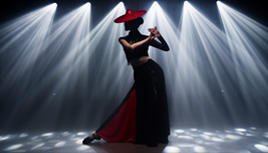The Role of Gobo Lights in Modern Lighting Design
In the realm of modern lighting design, gobo lights have emerged as a versatile and creative tool for lighting designers. These innovative projectors allow designers to project custom patterns, logos, and images onto various surfaces, giving them the ability to transform any space with dynamic and engaging visuals.
Bringing Design to Life with Gobo Projectors
The primary function of gobo projectors is their ability to project intricate and highly customizable images, patterns, or logos onto walls, floors, and other surfaces. Whether it’s casting organic patterns of foliage across a garden pathway or projecting a company logo onto a building façade, gobo lights provide designers with the freedom to add texture, movement, and branding into their lighting schemes. This ability to customize projections makes gobo lights an essential tool for both architectural and event lighting design.
The Creative Power of Image Projection
An exciting development in lighting design is the use of image projection lights that can showcase not only static images but also dynamic and animated projections. Designers can create mesmerizing visual effects by utilizing moving patterns or even changing colors, enhancing the ambiance of a space. For example, gobo projectors can project moving water patterns on the floor of an art gallery or animate clouds passing by on the walls of an outdoor event space, adding depth and intrigue to the environment.
Enhancing Branding and Aesthetics
One of the most practical uses of gobo lights is in branding. Many companies now use gobo projectors to project their logos onto building exteriors, event spaces, or even as part of experiential marketing campaigns. This method ensures brand visibility in a unique and memorable way, enhancing the overall aesthetic of a space while leaving a lasting impression.
Energy Efficiency and Innovation
As lighting design trends increasingly focus on sustainability, gobo projectors offer energy-efficient alternatives to traditional lighting systems. LED-based gobo projectors not only provide long-lasting performance but also minimize energy consumption while delivering bright, high-quality projections. This makes gobo lights an eco-friendly solution for designers who are mindful of energy use and environmental impact.
Here’s a breakdown of gobo projectors:
1. Waterproof Gobo Projectors (IP Rating)
- Functionality: Waterproof gobo projectors are designed for outdoor use and typically come with an IP65 or higher rating. This ensures that the projector can withstand harsh weather conditions such as rain, dust, and humidity. It is essential for consistent performance when installed outdoors.
- Example: An IP65-rated gobo projector might be used in outdoor landscaping, such as projecting tree branch patterns across a garden pathway during a rainy event. These projectors provide uninterrupted performance regardless of environmental factors.
- Data: A projector with an IP65 rating ensures complete protection against dust and low-pressure water jets from any direction.
- Functionality: Gobo projectors come with a range of power options, from lower-powered units suitable for small indoor applications to high-powered models designed for large outdoor spaces or grand events. The power rating of a gobo projector directly correlates with the brightness of the projection.
- Example: A high-power LED gobo projector (100W-150W) is ideal for projecting intricate logos on large building facades, ensuring that the logo is visible even from a distance during the daytime.
- Data: For large outdoor areas, projectors with power ratings of 150W or higher provide more brightness, which is crucial for visibility during daylight.
- Functionality: Some gobo projectors offer zoom functionality, allowing users to adjust the beam angle. This flexibility is ideal for projecting either small, focused patterns or expansive images across large surfaces.
- Example: A gobo projector with zoom can be used at an event where it first projects a small logo on a wall, then zooms out to cover a larger surface, projecting a scenic pattern or dynamic effect across the entire building.
- Data: Zoomable projectors typically have a beam angle range from 10° to 40°, enabling designers to choose between concentrated beams or broad coverage.
- Functionality: Custom gobos are available in various materials such as glass and metal, which affect the projection’s quality and durability. Glass gobos are best for detailed designs and high-resolution patterns, while metal gobos offer durability and are used for simpler, high-contrast designs.
- Example: For an upscale event, a glass gobo could be created to project detailed floral patterns onto the floor, while a metal gobo may project a company logo in a stark black-and-white design onto a wall.
- Data: Glass gobos are typically used for high-definition and intricate designs, while metal gobos provide longer-lasting durability and sharper projections for simpler designs.
- Functionality: Gobo animation is a feature that allows gobo projectors to project moving patterns or logos, creating a dynamic and engaging visual effect. This function is commonly used in events, stage productions, and public spaces.
- Example: At a music festival, a gobo projector with animation can project moving waves across the stage or dynamic abstract visuals that flow across the background.
- Data: Gobo animation typically involves rotating or moving gobos within the projector, which can be synchronized with other lighting effects via DMX control.
- Functionality: Prism effects allow gobo projectors to split the light into multiple beams, creating stunning visual effects that add depth and dimension to the projections. This is particularly effective for creating dramatic and immersive lighting displays.
- Example: During an outdoor event, a gobo projector with prism effects could project beams of light that scatter across a large outdoor venue, creating an exciting and visually engaging environment.
- Data: Prism effects can add multiple rays of light, enhancing the overall impact of projections. This feature is ideal for concerts or large outdoor festivals.
- Functionality: Many advanced gobo projectors feature image correction technology, ensuring that the projected pattern is clear and aligned, even when projected onto uneven or curved surfaces.
- Example: A gobo projector projecting a logo onto a curved building façade can use image correction to ensure that the logo appears straight and undistorted, despite the curved surface.
- Data: Image correction often includes features like keystone correction, which allows for precise projection alignment even in non-standard projection angles.
- Functionality: DMX control is a standard feature for modern gobo projectors, allowing them to be synchronized with other lighting fixtures for coordinated effects. This feature is essential for large events or installations where multiple lights need to operate in unison.
- Example: During a theater production, DMX control can be used to synchronize gobo projectors with stage lighting and sound, ensuring that the projections change with the mood or action on stage.
- Data: DMX-controlled gobo projectors offer precise timing and synchronization, enabling seamless transitions between effects.














